Hotel Poytaht is a Dushanbe landmark. It's a huge Soviet-style hotel near the train station, and it's actually a reasonably attractive low-slung building that is four or five stories tall with two long wings angling off the central reception area. It's supposed to have reasonable rooms on the top floor that are charged on a per-person basis (and may or may not involve sharing), but they didn't want to sell me this sort of room, and said the lowest room was something like $30 or $40. The difference was academic to me, as either total was more than I wanted to spend.
I headed to a small supermarket nearby to get something to drink, and to plot out my next plan of attack. I figured out I would try the Farhang hotel, which is supposed to be cheap even if it's not exactly central. I hopped a bus headed in that direction, and found the hotel without too much difficulty (being behind the UFO-shaped circus, which itself was just off the major road the bus traversed, made this pretty easy). Whereas the Poytaht was well-maintained and a clean version of Soviet "hospitality," the Farhang had the dilapidated and scruffy feeling more familiar from Kyrgyzstan. For such a large hotel, I had to wait in the lobby until an attendant showed up, but the rooms were a bargain (for Dushanbe) at 60 somoni.
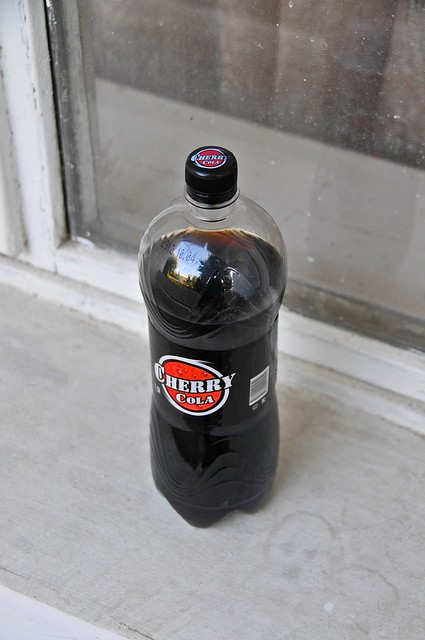 |
| I love Cherry Coke. This is no Cherry Coke. |
While Kyrgyzstani supermarkets were surprisingly Russian/Western, most of the things they sold were fairly local, or possibly from Turkey. In Dushanbe, a lot more things were imported from Europe, and a lot of things that would have been locally-produced in Kyrgyzstan were imported. Maybe the best example is Coke and Pepsi. Thomas Friedman's
McDonalds theory of war says that no two nations with McDonalds outlets have ever gone to war (which was true until the Russia-Georgia conflict), and to a certain extent I think this really says something about the stability of nations with McDonalds. I think that the existence of foreign brands in a country says a lot about the investment climate and political stability and predictability in that country, and in this context it's interesting to note that Tajikistan is the only country in Central Asia that
does not have a domestic Coke or Pepsi bottling facility: these products are officially imported from Kyrgyzstan, and unofficially imported from Afghanistan. The locally-bottled brand is RC Cola, which is more or less extinct in most corners of the world.
This lack of locally-produced goods inevitably means that things tend to be more expensive in Tajikistan than in Kyrgyzstan, which is unfortunate given that Tajikistan is even poorer than Kyrgyzstan. If your only exposure to the country was Dushanbe, however, it certainly wouldn't feel very poor—even if your only basis of comparison was with Kyrgyzstan's most prosperous city, Bishkek. Now, it's no surprise that large, capital cities feel more prosperous than other parts of the country, especially when the capital cities are orders of magnitude larger than any other city in the country. But even given this, it's pretty clear that a
disproportionate amount of public funds have been spent beautifying the capital, and that a disproportionate amount of money resides in the capital. The old, Soviet-era public buildings in Dushanbe are better maintained and more attractive than they are in Bishkek. As mentioned earlier, the stores stock more imported goods, at higher prices. You see a lot more late-model luxury cars and European imports in Dushanbe than Kyrgyzstan (although I believe that many of them are stolen), with models like BMW X6 models being not hugely unusual.
What really sets Dushanbe apart from Bishkek, however, is that in Dushanbe you can see new construction and new monuments being built by the government and
President Rahmon (who has ruled since 1992). Sure, Nazarbayev is doing the same thing in Astana, but the key difference is that Kazakhstan is riding a wave of resource-based prosperity, while Tajikistan remains dirt poor. Despite this, in Tajikistan the villages remain poor while Dushanbe is beautified.
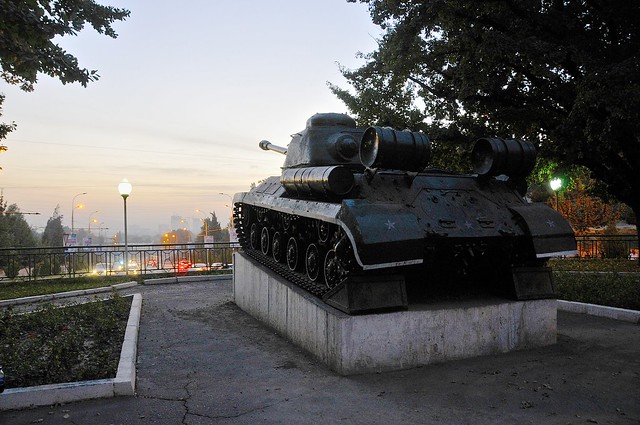 |
| Old Soviet tank in old-style park takes aim at the skyline. |
 |
| Imposing monuments (this one to Ismail Samani), empty plazas surrounded by barricades, and armed guards make these public spaces less than inviting. Pedestrians walking by skirted the plaza in front instead of taking the shortcut across, so I had to ask the guard to ask if it was possible to approach the monument and take a picture. |
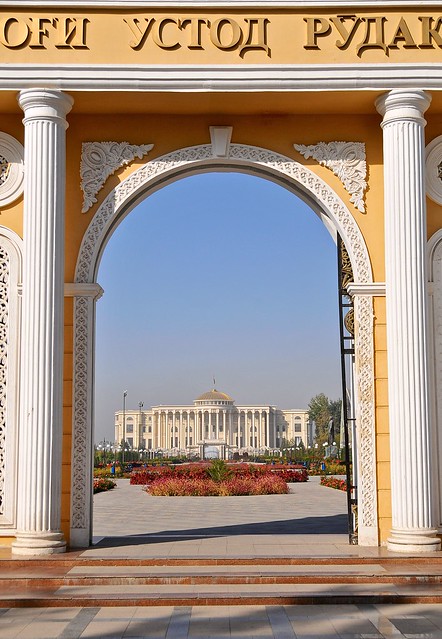 |
| The Presidential Palace. |
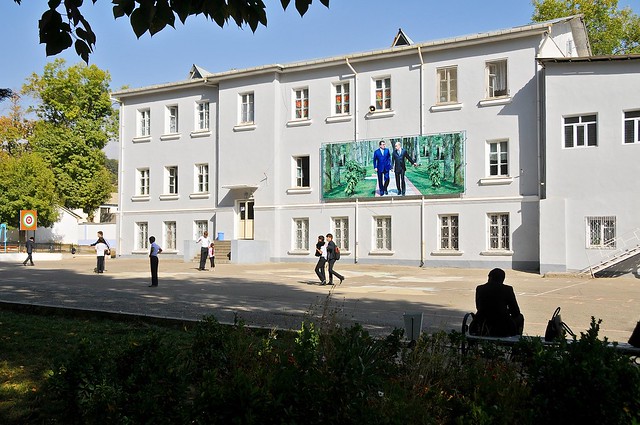 |
| Next to Turkmenistan, Tajikistan is the Central Asian country that most aggressively promotes a personality cult around its leader, Rahmon. Pictures of him heralding his accomplishments and profound statements ("Education is good!") are everywhere. Putin looks like a wimp next to him. |
 |
| Detail from a monumental building along Rudaki. |
 |
| Chopping down a tree near the old Afghan embassy. |
 |
| Interesting Soviet apartment design with cool balcony sunshade latticework. |
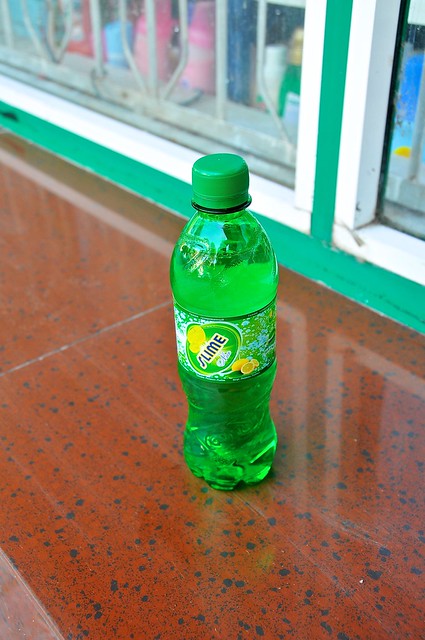 |
| If you don't speak English, I'm sure "Slime" sounds like a good name for a Sprite-like lime drink. |
Dushanbe means "Monday" in Tajik, and the city got its name after its Monday market. Today, Dushanbe's central Green Bazaar is one of my favourite markets in Central Asia. It's basically a large square with external shops along the perimeter and then a few buildings and concentric market buildings within. In the middle is the green market area where fruits and vegetables are sold, and there are different areas along the perimeter selling everything from canned and packaged foods, to hardware, to meat, to clothing, and so much more. It isn't the strung-out maze that Osh's bazaar is, and in Dushanbe they have a much more attractive way of presenting produce than they do in Kyrgyzstan (they make careful little pyramids of fruit, which is more typical of Central Asian bazaars—Kyrgyzstan's haphazard presentation is something of an anomaly).
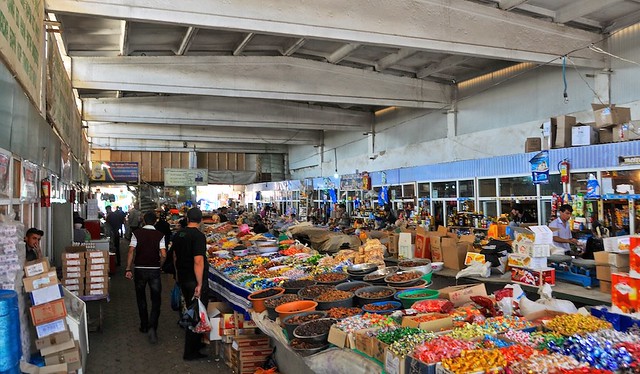 |
| The bulk candy section. |
 |
| Eggs and chickens line this wing. |
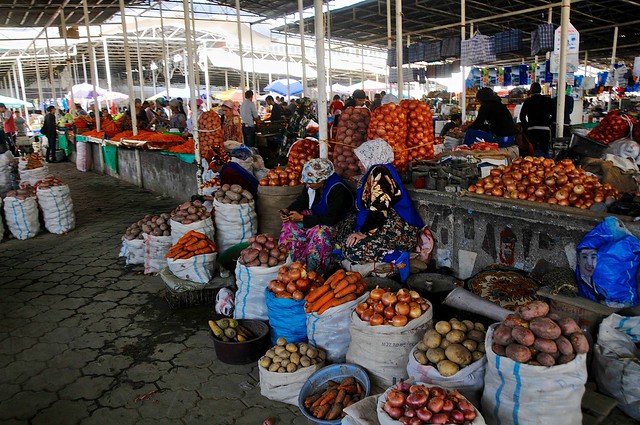 |
| Fruits and vegetables in the center of the market. Notice how conservative a lot of the women in these pictures are—lots of headscarves and traditional dress, which you see in quite a few younger women, as well. |
 |
| The best dining deal in Dushanbe: 4 somoni for plov with meat, tomato salad, and half a naan. All of it was really good. To plate the salad she just reaches into a bucket of salad, pulls out a handful, gives it a squeeze to wring out excess juices and liquid, then drops it on your plate. |
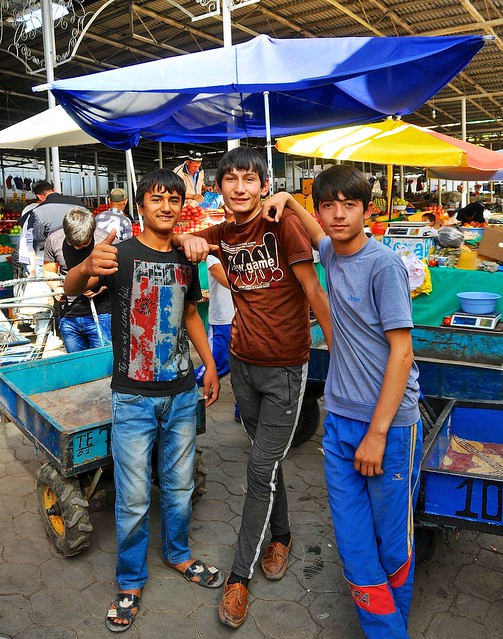 |
| These young porters asked to have their pictures taken. I usually try to be discreet when taking pictures in markets, as they are just folks going about their business without necessarily wanting to be photographed. People who buy lots of stuff hire these guys to carry their purchases to their cars. |
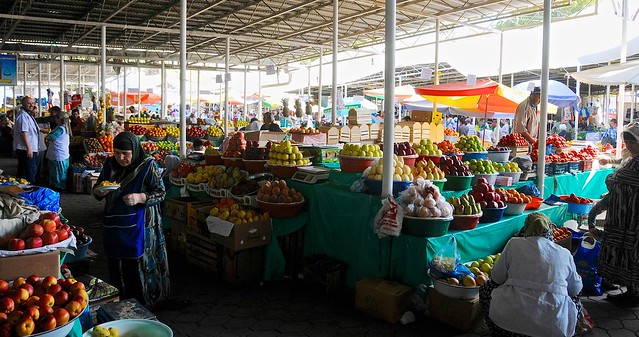 |
| Fruit on the northern half of the center. |
Visa time
One of my big objectives in Dushanbe was to collect more visas. The Uzbek visa, now that I had a letter of invitation, should be easy, and the Dushanbe embassy was supposed to be a good place to get a Turkmen transit visa. I also wanted to get an Afghan visa, as I had heard the Afghan side of the Wakhan corridor was both safe and incredible (the Dutch guy I had met in Pingyao had said that he went there for a few days and ended up going to villages where some people had never seen a westerner before), and I also wanted to exit Turkmenistan to Afghanistan to see Herat, before jumping over to Mashhad, Iran.
The tricky part would be the Turkmen transit visa, because they require you to already have the visa for the ongoing country (which would be Iran or Afghanistan) before they'll issue you a transit visa. For some reason I thought they would also require you to have the visa from the country you're entering from, but in reality they don't care since if you don't get that visa you'll never enter Turkmenistan and won't need the visa in the first place. Because of my misconception, I thought I had to get my Uzbek visa first, so on my first day in Dushanbe I went to the Uzbek embassy.
Now, there are a lot of Tajiks in Uzbekistan as a result of intentionally divisive border-drawing by the Soviets. Both Samarkand and Bukhara are (or were) majority-Tajik cities, yet both were put inside Uzbekistan. And because of bad relations between the two countries (nobody seems to get along with Uzbekistan), the Uzbeks require Tajiks to get a visa in order to visit. This is ridiculous, given that Russia allows pretty much all Central Asians to visit visa-free (this is why it is such an attractive target for migrant workers), and even though the visas are cheap, it is a good way to jerk around Tajik citizens. It's also a good way to damage Tajik tourism, as the Uzbeks have decided to keep the border between Penjikent and Samarkand closed, so what could be a 60 km trip now requires a huge detour and a couple of days.
(
Edit: as of March 1, 2018, the border between Samarkand and Penjikent is open for tourists and locals alike. This is huge news for travelers and a result of the thaw in relations following the death of the Uzbek strongman Islam Karimov in 2016.)
This means that the Uzbek embassy is surprisingly busy. When I arrived there was a crowd of people waiting outside, and you have to queue up and give your passport to a guard outside the visa office, who will then let you in or make you wait. Most of the people outside had already been inside and were waiting to be called for their visa, or to meet with someone about their visa. I was briefly let in and given an application, then I had to leave again to complete the application and make some copies. I returned and eventually submitted my application to unfriendly officer who sent me away. While waiting outside, one of the Tajiks struck up a conversation. He was a student studying in St. Petersburg, home on vacation. He wanted to visit a relative in Uzbekistan who was getting married. He had made multiple trips to the embassy to get a visa, but they kept delaying and putting him off. After waiting a couple of hours in the morning he was told to come back at the end of the day. I was eventually called, and when I received my visa I discovered that they had totally ignored the visa dates specified on my letter of invitation and had instead simply issued me a 30-day visa that began running on that day! This was a bit of a disaster, as it meant that if I stayed in Tajikistan for another 15 days then I would only have 15 days in Uzbekistan. On the other hand, it's a good thing I got my Uzbek visa before my Turkmen visa, otherwise I might have asked for my Turkmen visa to begin on a date when I was no longer allowed to be in Uzbekistan.
After collecting my Uzbek visa in the early afternoon I decided to see about an Afghan visa, as I would need this if I wanted to exit Turkmenistan to Herat. I went to the supposed location of the Afghan embassy, but it was no longer there. I was at a bit of a loss, so I approached the guard station at the nearby British embassy (I figured they probably spoke English) and asked if they knew where it was. Apparently it had moved a fair distance west to the other side of the river. They told me which marshrutka to catch to get there, and as I was walking down the road an embassy staffer passing by in a pickup truck said he was headed in the direction and offered to give me a lift. How nice!
The Afghan embassy is a huge new building staffed by absolute nitwits. I went into the visa section and tried to ask about visas: whether it would be possible to get a double entry visa; whether their visas started running from the date of issue or if I could designate the start date, and whether I could get a visa valid for more than 30 days. Their basic approach to visas, however, is: fill out the form, go pay your fee at the bank, come back to us with the receipt, then come back in 2 days to pick up your visa. Not helpful. I repeated my questions, which led to a conference between consular officials. I told them I wanted to visit the Wakhan and then visit Herat later. The older-but-not-wiser official said that I would need a transit visa to do the Wakhan portion of my trip, even though I would not be transiting between two countries but simply making an excursion from Tajikistan before returning there. No matter, I would need a transit visa... and he couldn't give a transit visa because I had already used my Kazakh visa. What?! Afghanistan doesn't even border Kazakhstan! They then repeated how I needed to go pay at the bank, for some sort of visa that would start on some sort of date and be for some number of entries. They then refused to answer any more questions and said they were closing, even though it was 15 minutes before closing time, slamming the window closed.
After that, I figured I wouldn't be visiting Herat unless it was possible to change my Turkmen visa's exit port after issue, which seemed unlikely (or bribing a Turkmen official at the border, which seemed more likely).
The next day I visited the Turkmen embassy, which near the northern entrance to the botanical garden. You have to sign in with the guardbox on the street, then probably sit and wait on the bench in the alley before being let into the compound and going to the visa office. Once there, you'll meet the friendly consul who will help you with the application and even tell you that you can change your dates when you pick up your visa. This can be important, as Turkment transit visas are ridiculously restrictive, as the specify the ports of entry and exit, and are only valid for a specific period of no more than 5 days (some unlucky people don't get the 5-day transit visa, but only a 3-day visa; Dushanbe is a good place because almost everyone gets the full 5 days, unlike at other embassies). I wasn't going to need to change my dates, however, as the stupid Uzbek visa meant that I would be using every single day of my Uzbek visa before leaving to Turkmenistan. Two weeks is the normal processing time for the Turkmen visa, but I paid an extra $10 to get it in one week. Since the clock on my Uzbek visa was already running, I would collect it in exactly one week and then immediately head to the Pamirs.
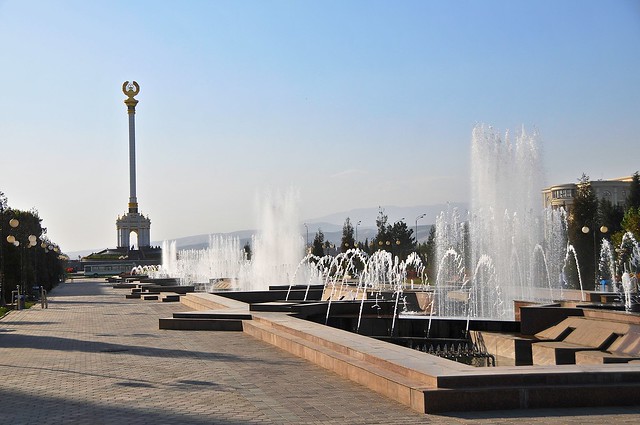 |
| Rudaki park's answer to Astana's chicken-on-a-stick monument. |
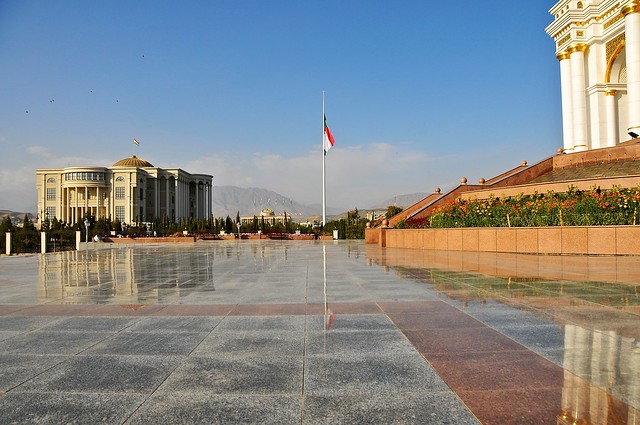 |
| This is (or was) the world's largest freestanding flagpole. |
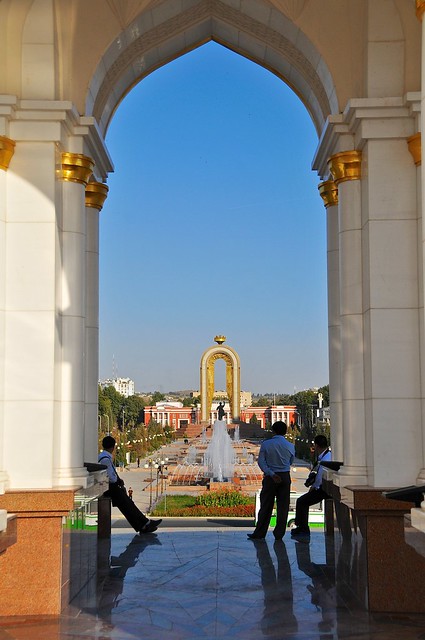 |
| These guys take pictures of tourists then print them out on the little battery-powered printers they carry. More photographers than tourists, unfortunately. |
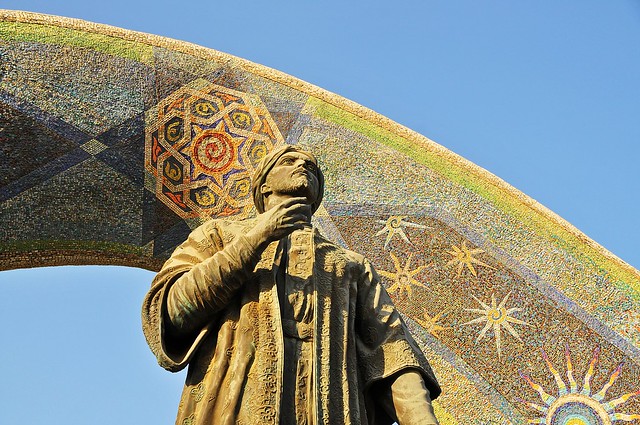 |
| Rudaki was one of the most famous Persian poets, and was supposedly born near Penjikent in the 9th century. |
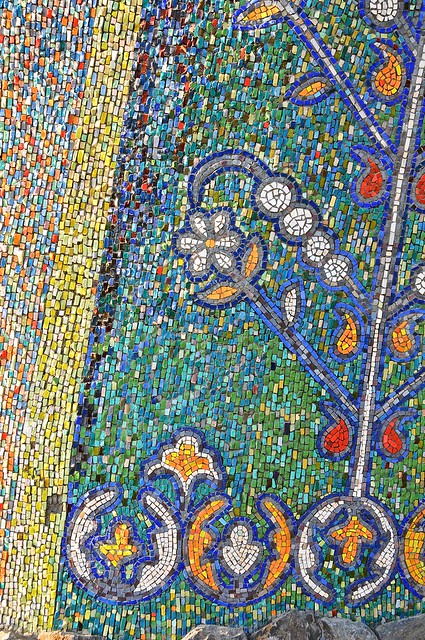 |
| Detail of the Rudaki monument's mosaic arch. |
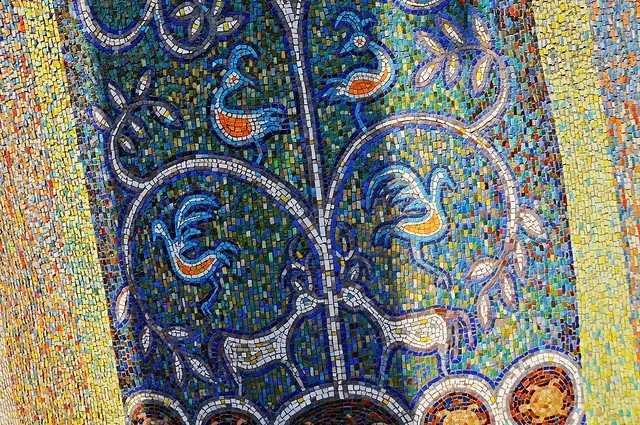 |
| At least the money spent on this monument actually resulted in something attractive. |
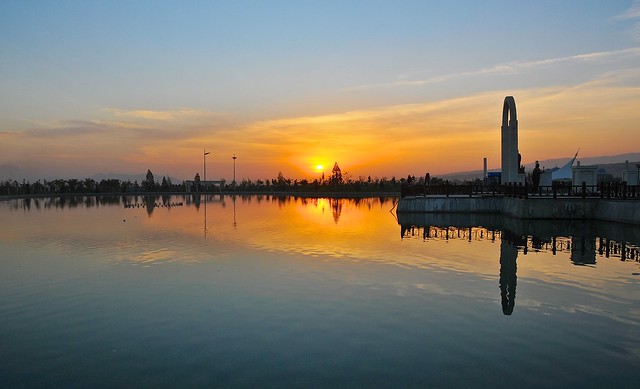 |
| Sunset. I was approached here by a few Tajiks who wanted to talk to me. I was surprised that one of them was a young woman in a scarf and traditional dress who left her girlfriends and came up basically to ask me to friend her on Facebook. Another was a guy who came up to talk a little and tell me about how cheap (newly-stolen) BMWs were in Dushanbe compared to Germany, and then to ask me about sex and virginity. A little weird, but asking about sexual mores kind of makes sense. |
 |
| The flagpole is so high that I couldn't capture the entire thing with my lens zoomed all the way out to 18 mm. |
 |
| Panorama of the lake, showing just how big the flagpole is. |
 |
| Typical Soviet-style monument, on Aini square near the Hotel Poytaht. |
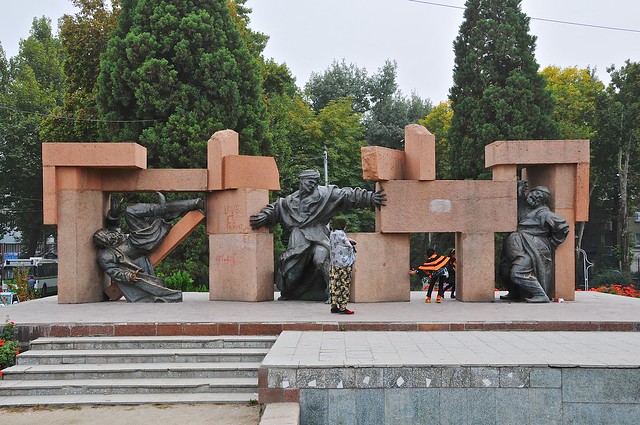 |
| The design of old parks and monuments imparts a Russian, northern feeling to some parts of the city, but the new monumental architecture and layout is a sharp break from Russo-Soviet design. |
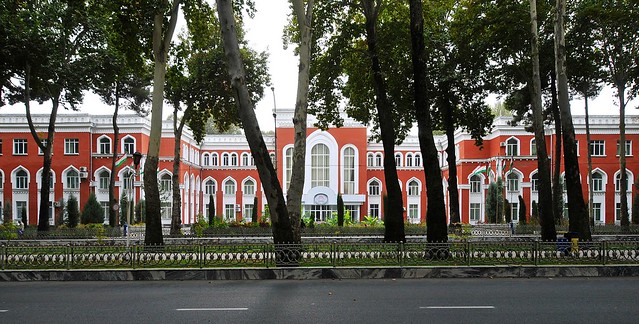 |
| Pretty Soviet-era university building along Rudaki, the lower section of which is a divided boulevard with a central tree-lined pedestrian park. |
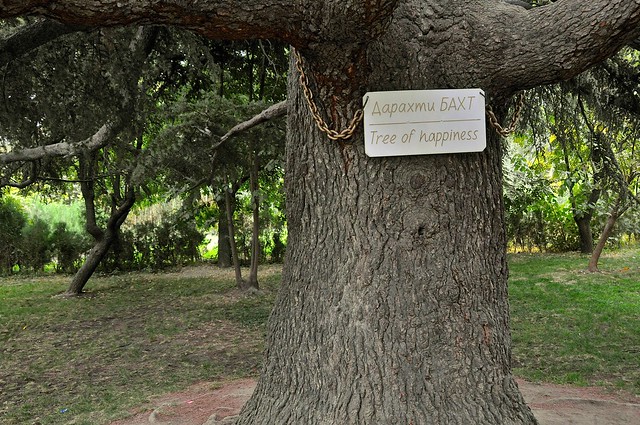 |
| The botanical garden, located fairly close to the Turkmen embassy, is a pleasant place to spend a few hours. |
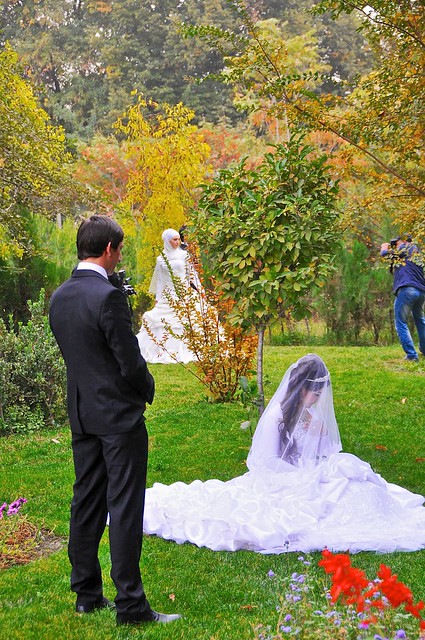 |
| The gardens are a popular site for wedding photos The bride in the background is interesting for being the first and only bride I saw with a hijab and western dress. |
Hospitality & taarof
The Tajik guy I had met at the Uzbek embassy had invited me to dinner with his wife and given me his contact information. I had said I would try to make it, that I wasn't sure if I would be able to. I also didn't have a cell phone and internet cafes are not that ubiquitous outside of the city center, so by the time I got through going to the different embassies it was relatively late, and I emailed him an apology later that evening when I got back to the Farhang. He replied to say it was too bad, and that his wife had been waiting to meet me, and I will admit I was a little surprised at how serious he seemed to have been. The reason for my surprise basically revolves around the idea best expressed in the Farsi word '
taarof,' which refers to ritualized offerings of hospitality and generosity which are not really meant. In Iran, this leads to a feeling of insincerity in a lot of social (and even business) transactions, where people offer things with the expectation that you'll decline—and you're rude if you don't decline once or twice.
Now, in some ways taarof may be uniquely Iranian in its extremes—and that notwithstanding the Iranian people are hugely and genuinely hospitable despite taarof—but even in other countries with traditions of hospitality I think there are some elements of taarof in social interactions. I mean, obviously you can't stop for tea dozens of times per day, so my sense was that many of the invitations a traveler receives were a mix of politeness and curiosity, but with not much social investment into them.
In this case I seemed to have been wrong (possibly because he was living in St. Petersburg and was used to speaking without taarof), and I felt bad that I had let him down and inconvenienced him. On the other hand, it made me feel that all offers of hospitality are genuine, and this may have also been the incorrect impression. Because while one sometimes hears that thee isn't much taarof in Tajikistan and Central Asia, in retrospect I believe it's a phenomenon that still survives at some level, especially in more rural areas.
Heck, we even practice our own variety of taarof in the west all the time. I even used it when I said that I would love to accept his invitation, even though I probably knew I would be unlikely to make it.
The first attempt to get a plane ticket to Khorog
The procedure for getting a plane ticket to Khorog is pretty difficult. You have to book in person at the airline office located a couple of blocks west of the airport building, and you basically have to book the day before. The reason for this is that the Dushanbe-Khorog route is flown at low altitude, and that you don't fly above the mountains but between them, and the plane only flies when the skies are clear. This being the case, it means that flights are regularly cancelled, and people who are bumped have priority to fly the next day. Obviously you can't sell lots of tickets in advance, and everyone has to book at the last minute. You are supposed to show up at the office in the late afternoon, and if they are going to sell you a ticket they'll take your passport details and collect your money.
I stopped by a travel agent I saw in downtown Dushanbe, and although the proprietors were friendly, they confirmed that the only way you could buy a ticket was to actually visit the Tajik Air office near the airport.
I tracked down this office (shown on the map below) and asked about buying a ticket for the next week, after my Turkmen visa would be ready, but they told me it wasn't possible and that I should show up on the 22nd to buy a ticket. They took my name (I showed them my visa so they could copy it down in Cyrillic) and noted when I wanted to fly. Well, at least I knew how the process would go.
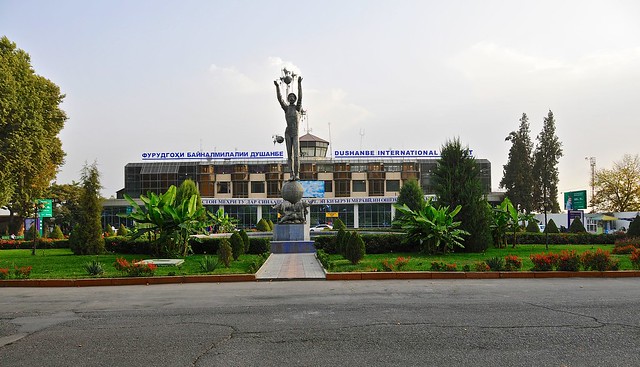 |
| The airport looks pretty tropical, and Dushanbe was right around 20°C when I was there in mid October. |
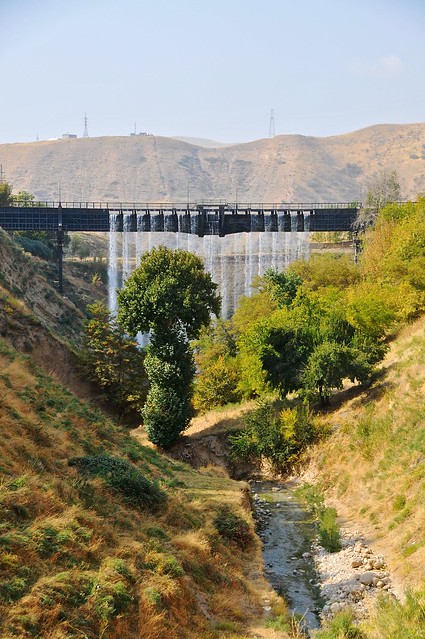 |
| View from Rudaki near the cement factory. Some sort of weird aqueduct with sluice gates making a waterfall. I don't know if this is to bleed off excess supply or some sort of weird way to create the stream that runs in the valley. |
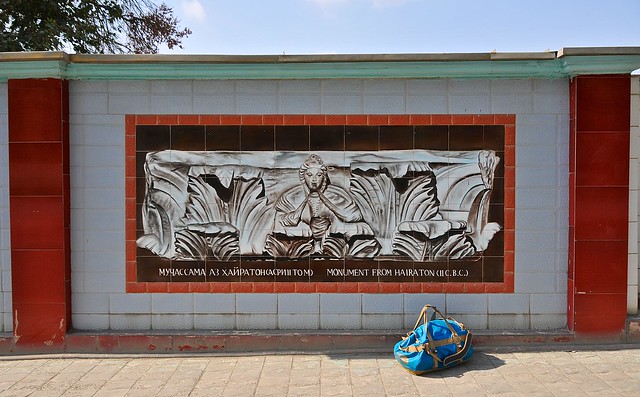 |
| A strange monument on the wall running next to the cement factory. |
Both the 2010 and 2014 Lonely Planets refer to the cement factory as the departure point for share taxis north to Penjikent and Khojand, but when I was there no cars really gathered at the cement factory. There were one or two, but I don't know what they were doing there and they didn't seem to be looking for passengers. Instead, the real taxi stand was a kilometer or so further north, where the buses that run along Rudaki turn around (simply take the buses listed in LP to the very end of the line), as shown in the map below. You can see there are a lot of cars in the semi-circular lot, and they were all headed north.
Budget
October 11, 2012, Dushanbe: 152.50 somoni
- Breakfast for 3: 6 somoni
- Lunch for 3: 57 somoni
- Bribes: 3 somoni
- Cherry soda, Bounty chocolate bar: 7 somoni
- Bus: 0.7 somoni
- Room at Farhang: 60 somoni
- Pomegranate drink, coke, soups, cereals, biscuits, candy: 18.80 somoni
October 12, Dushanbe: 114.10 somoni, $75
- Uzbek visa: $75
- Internet & photocopying: 8 somoni
- Ice Cream (1.2), bread (4), & RC Cola (3): 8.2 somoni
- Ice cream, cherry soda, Yoghurt, snacks: 13.9 somoni
- Chicken: 22 somoni
- 2 hours of internet: 4 somoni
- Room at Farhang: 60 somoni
October 13, Dushanbe: 93 somoni
- Black currant jam & "slime" soda: 10 somoni
- Plov, bread, pepsi: 8 somoni
- 2x bread, RC Cola, wafers, ice cream: 15 somoni
- Room at Farhang: 60 somoni
October 14, Dushanbe: 100.7 somoni
- Internet: 13 somoni
- Shwarma (7), popcorn (1), bread (2): 10 somoni
- Chicken "burrito": 7 somoni
- Berry jam & botanic pasta: 10 somoni
- Bus: 0.7 somoni
- Room at Farhang: 60 somoni
October 15, Dushanbe: 123.50 somoni
- Chocolate, biscuit, ice cream: 8 somoni
- Chicken: 20 somoni
- Bread, tomatoes, cucumbers: 5.5 somoni
- Lunch at market: 10 somoni
- 1.5 liter RC: 5 somoni
- Bus: 2 somoni
- Room at guesthouse: 73 somoni













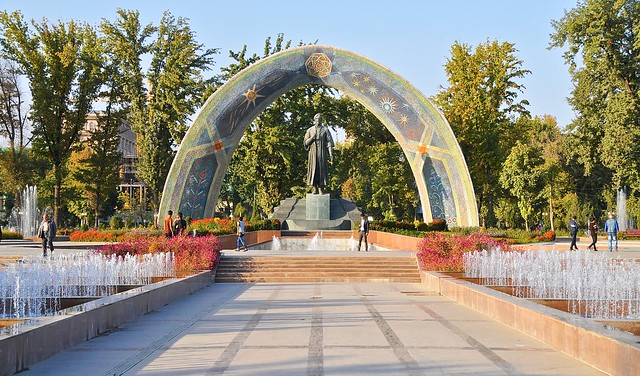








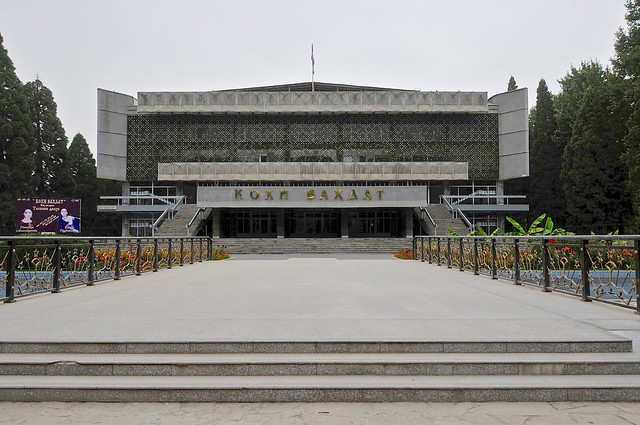











No comments:
Post a Comment